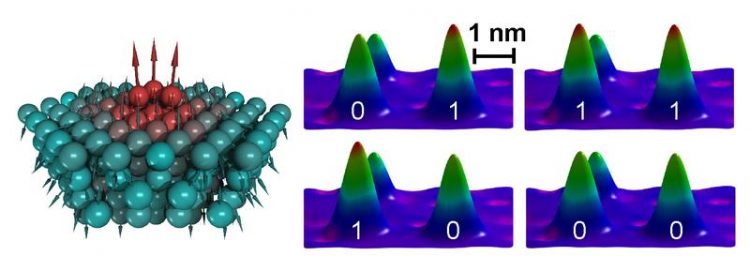Stable magnetic bit of three atoms

Illustration of the constructed magnetic bit composed of only three iron atoms on a platinum substrate
A reoccurring challenge in storage technology is the continuing demand for smaller “bits”, which is the fundamental storage unit. In magnetic memories this information is stored in the magnetization of small magnets. The need to store more and more information in a smaller and smaller area therefore involves the question of how small we can make a magnet which still keeps its magnetization for a prolonged period of time such that the information is not lost.
Recently, extensive research in this direction has approached the ultimate limit of storing information in individual atoms. A particular challenge for the use of such small storage elements was the destabilization of their magnetization by the interaction with the electrons of the substrate they are positioned on. Consequently, the prevalent approach in order to stabilize the magnetization was to strongly decouple the magnetic bit from the substrate electrons by the use of insulating layers.
However, this route entails the problem that the processing of the information the bit carries for computational purposes, which is done via exactly those substrate electrons, is rather difficult to achieve. To this end, a bit made of a few atoms which are positioned directly on a conductive substrate is highly desirable.
A team of experimentalists and theoreticians of the University of Hamburg in cooperation with the Forschungszentrum Jülich and the Radboud University in Nijmegen have now experimentally realized such a bit. The bit was constructed by using the magnetic tip of a scanning tunneling microscope as a tool for putting together only three iron atoms on a conductive platinum substrate (see the Figure, left panel). They were also able to use the magnetic tip in order to write information into a storage register of two of such bits (see the Figure, right panel) which keeps the stored information for hours.
By using conductive platinum as a substrate, the researchers were able to achieve an intriguing magnetic structure inside the bit and substrate (see the Figure, left panel): the magnetization of the individual constituents of the bit is not aligned parallel, as in conventional magnetic storage elements, but in a much more complex, so called non-collinear, fashion.
This non-collinearity enables to transmit the stored information to neighboring components using a large variety of angles between the magnetizations, other than just 0° and 180°, which will add more flexibility to information processing schemes.
Figure: Left panel: Illustration of the constructed magnetic bit composed of only three iron atoms on a platinum substrate. The arrows indicate the peculiar magnetization inside the bit which carries the information. Right panel: Magnetic images of the four possible states of a register of two of such magnetic bits. In these images, the height of the two bits reflects their state (0, low and 1, high). The iron atom in the back serves as a marker for the height of a tenth of a nanometer.
Original publication:
A gateway towards non-collinear spin processing using three-atom magnets with strong substrate coupling, J. Hermenau, J. Ibañez-Azpiroz, Chr. Hübner, A. Sonntag, B. Baxevanis, K. T. Ton, M. Steinbrecher, A. A. Khajetoorians, M. dos Santos Dias, S. Blügel, R. Wiesendanger, S. Lounis, and J. Wiebe,
Nature Communications (2017).
DIO: 10.1038/s41467-017-00506-7
Media Contact
All latest news from the category: Information Technology
Here you can find a summary of innovations in the fields of information and data processing and up-to-date developments on IT equipment and hardware.
This area covers topics such as IT services, IT architectures, IT management and telecommunications.
Newest articles

Can lab-grown neurons exhibit plasticity?
“Neurons that fire together, wire together” describes the neural plasticity seen in human brains, but neurons grown in a dish don’t seem to follow these rules. Neurons that are cultured…

Unlocking the journey of gold through magmatic fluids
By studying sulphur in magmatic fluids at extreme pressures and temperatures, a UNIGE team is revolutionising our understanding of gold transport and ore deposit formation. When one tectonic plate sinks…

3D concrete printing method that captures carbon dioxide
Scientists at Nanyang Technological University, Singapore (NTU Singapore) have developed a 3D concrete printing method that captures carbon, demonstrating a new pathway to reduce the environmental impact of the construction…



